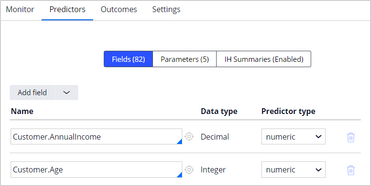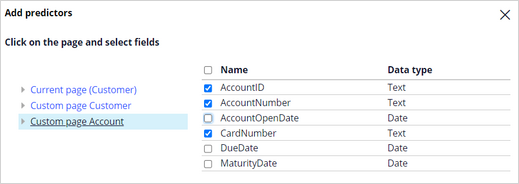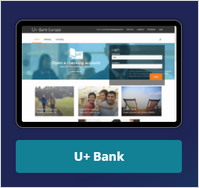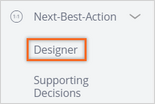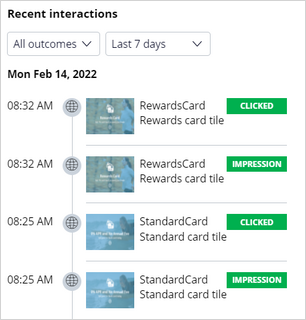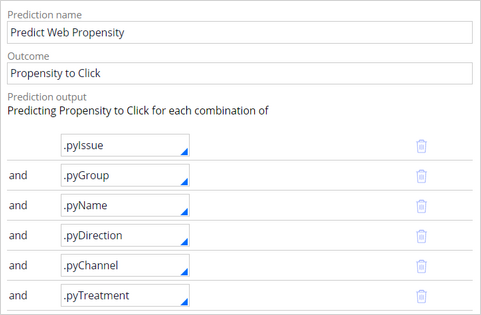
Adding predictors to an adaptive model
3 Tasks
10 mins
Scenario
U+ Bank is implementing cross-selling of their credit cards on the web by using Pega Customer Decision Hub™. The implementation team has set up the business taxonomy, contact policy rules, arbitration, and the real-time containers in Next-Best-Action Designer.
After the initial setup, the team added additional account information, and used Pega Customer Profile Designer to implement industry-specific best practice clickstream summaries. The summaries extend the customer profile with real-time behavioral data. As a data scientist, you make this added data available to the adaptive models.
The decisioning Architect then verifies that the adaptive models work properly by simulating customer behavior on the U+ Bank website and monitoring the propensity for the target and alternative customer behavior.
Use the following credentials to log in to the exercise system:
| Role | User name | Password |
|---|---|---|
| Data Scientist | DataScientist | rules |
| Decisioning Architect | DecisioningArchitect | rules |
Your assignment consists of the following tasks:
Task 1: Configure new predictor fields.
As a Data Scientist, validate that most of the customer properties are already configured as predictors for the Web_Click_Through_Rate model. Enhance the predictor list with the recently added properties from the Custom page Account page, except those with an absolute data type.
Tip: It is recommended to use the relative Time Elapsed data type for date predictors.
On the Custom page Customer > FSClickstream page, add all fields to the customer profile. Inspect the settings tab of the model.
Note: The model update frequency is set to 1 to allow learning of the adaptive models on a very low volume of responses in this challenge. In a production system, the default value of 5000 should not be changed lightly.
Task 2: Verify adaptive learning on target behavior.
Successively log in to the U+ Bank website as Troy and click the offer.
Caution: Click the banner within one minute to record the target Clicked response, otherwise an alternative response is recorded. Allow one minute between logins.
Use the Customer profile viewer > Decision history report to examine the Original model propensity values. Troy's subject ID is 14. Check that after multiple logins, the original model propensity of an offer increases when you click it.
Note: The final propensity calculated by the prediction does not only depend on the original model propensity, but also on a mechanism that introduces noise while the evidence is low. As the model learns on the target and alternative responses, the noise decreases. This ensures that new actions do get some exposure, even when their models are still immature.
Task 3: Verify adaptive learning on alternative behavior.
Successively log in to the U+ Bank website as Troy, but do not click the offer.
Caution: The alternative NoResponse outcome in recorded one minute after the impression and is used by the model to learn on alternative customer behavior. Allow at least one minute between logins.
Check that after multiple logins, the original model propensity of an offer decreases when you ignore it.
Challenge Walkthrough
Detailed Tasks
1 Configure new predictor fields
- On the exercise system landing page, click Pega CRM suite.
- Log in as a data scientist with User name DataScientist using Password rules.
- In Prediction Studio, click the Predict Web Propensity prediction tile to open the prediction.
- On the Settings tab, in the Prediction details section, click Configure.
- Confirm that the prediction predicts the propensity to click for each combination of offer, direction, channel, and treatment.
- Click Cancel.
Note: The control group field sets a percentage of customers that will receive a random offer.
- In the Response labels section, confirm that the Target label is Clicked, and the Alternative label is NoResponse.
Note: The Response timeout field is set to 1 minute for this exercise system. After the timeout elapses, the alternative label NoResponse is recorded.
- On the Models tab, in the Supporting models section, click Web_Click_Through_Rate to open the model.
- On the Web_Click_Through_Rate form, click the Predictors tab to view the list of available predictors.
- On the Predictors tab, expand the Add field menu and select Add multiple fields to open the Add predictors dialog box.
- In the Add predictors dialog box, expand Custom page Customer, and then click Page FSClickstream.
- In the Page FSClickstream list, select the Name checkbox to select all fields.
- Click Submit to add the predictors.
Note: The FSClickstream page represents the customer behavioral data that is introduced by the system architect after installation of the Customer Profile Designer Accelerator component that is available from Pega Marketplace.
- On the Predictors tab, expand the Add field menu and select Add multiple fields to open the Add predictors dialog box.
- In the Add predictors dialog box, click Custom page Account.
- In the Custom page Account list, select the Name checkbox to select all fields. Deselect all Date fields.
Tip: It is recommended not to use absolute Date fields as predictors, but use relative Date Elapsed fields.
- Click Submit to add the predictors.
- Click the Settings tab.
Note: Notice that the model update frequency is set to 1. This value allows learning of the adaptive models on a very low volume of responses. In a production system, do not change the default value of 5000 without first consulting a senior data scientist.
- In the upper-right corner, click Save.
- In the lower-left corner, click the user profile icon and log out.
2 Verify adaptive learning on target behavior
- On the exercise system landing page, click U+ Bank to launch the U+ Bank website.
- On the U+ Bank website, in the upper-right corner, click Log in to log in as a customer.
- In the Username drop-down list, ensure that Troy is selected, and then click Sign in. A credit card offer is displayed. Troy is eligible for two credit offers: The Standard Card and the Rewards Card.
- Click the Learn more link below the offer. Log in multiple times and click the Learn more link every time.
Caution: Click the banner within one minute to record a target response, otherwise an alternative response is recorded. Allow one minute between logins.
- On the exercise system landing page, click Pega CRM suite.
- Log in to Customer Decision Hub as a Decisioning Architect with User name DecisioningArchitect and the password rules.
- In the navigation pane on the left, click Next-Best-Action > Designer.
- In Next-Best-Action Designer, click Arbitration.
- Click Explore arbitration results to open Customer profile viewer.
- In the Customer Profile Viewer window, in the Customer ID field, enter 14, which is Troy's customer ID, and then click View.
- On the Overview tab, confirm that for each interaction an Impression and a Clicked outcome is recorded.
Note: The Impression outcome is recorded when the offer is presented to the customer.
- On the Decision history tab, click Load all decisions.
- Click Fields to select the field displayed in the decisions table.
- Select the fields that you want to see in the decisions table but ensure that you include the following fields: Decision time, Name, Final propensity, Model control group, Original model propensity, and Model evidence.
- Confirm that the Original model propensity starts at 0.5 and increases in response to the target behavior, and that the Model evidence increases with every interaction for both offers.
Note: The final propensity that the prediction calculates does not only depend on the original model propensity, but also on a mechanism that introduces noise when the evidence is low. As the model learns from the target and alternative responses, the noise decreases. This ensures that new actions do get some exposure, even when their models are still immature.
3 Verify adaptive learning on the alternative behavior
- On the exercise system landing page, click U+ Bank to launch the U+ Bank website.
- On the U+ Bank website, in the upper-right corner, click Log in to log in as Troy.
- Perform successive logins without clicking the offer, to generate alternative outcomes.
Caution: The alternative NoResponse outcome in recorded one minute after the impression and is used by the model to learn on alternative customer behavior. Allow at least one minute between logins.
- On the exercise system landing page, click Pega CRM suite to return to Customer profile viewer.
- On the Decision history tab, click Load all decisions.
- Select the fields that you want to see in the decisions table, but ensure that you include the following fields: Decision time, Name, Final propensity, Model control group, Original model propensity, and Model evidence.
- Confirm that the Original model propensity decreases in response to the alternative behavior, and that the Model evidence increases with every interaction for both offers.
This Challenge is to practice what you learned in the following Module:
Available in the following mission:
If you are having problems with your training, please review the Pega Academy Support FAQs.
Want to help us improve this content?


